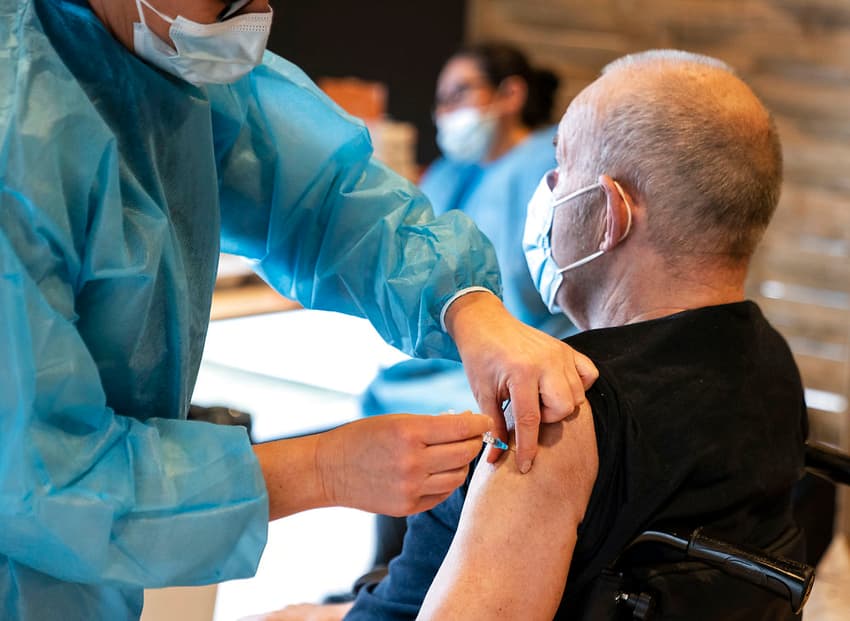Denmark’s Covid-19 vaccination programme feels effects of reduced supply

This week will see Denmark receive 73,710 doses of the Covid-19 vaccine from supplier Pfizer/BioNTech and 6,000 from Moderna.
The numbers were confirmed by the Danish Health Authority via its website.
All doses from Pfizer/BioNTech will be used on giving second doses to people who have already received one dose of the vaccine, so a low number of people will begin vaccination.
That comes after a recent announcement by the company that it would be delivering fewer doses than previously expected during coming weeks.
READ ALSO: Reduction in Pfizer vaccines to Denmark will impact first quarter of 2021
As such, people resident at care homes and people over the of 65 who receive living assistance at home will receive the Pfizer vaccines, as will key staff in the healthcare and social care sectors.
The Moderna vaccines will be used in the North Jutland region next week. They will be offered to people over the age of 85.
Last week, Denmark received 35,000 dosed of the Pfizer vaccine, around half of this week’s supply.
As a result, the health authority adjusted its plan for the vaccine rollout. That meant a delay to vaccines being offered to health sector workers.
Overall, Denmark will now receive around 10 percent fewer doses from the company in the first quarter of 2021 than was previously expected.
The vaccines are supplied in vials which, initially, were approved by the European Medicines Agency (EMA) to contain five doses of the vaccine. But clinicians in Denmark were able to draw six doses from the vials. That was taken into account in the country’s vaccine plan.
But the EMA has now updated its specifications to state that the vials contain six doses.
Because the contract between Pfizer/BioNTech and the EU Commission is based on doses, the company is maintaining it will still be supplying the agreed number of doses despite the reduced number of vials.
Though Danish authorities disagree with this understanding, it has resulted in the necessary revision of the country’s vaccine plan.
Danish Health Authority director Søren Brostrøm said the vaccination programme was moving forward well, despite the changes brought about last week.
“We are maintaining our set prioritisation order and we have already vaccinated many in the highest target groups and are well underway with dose two for the elderly and people at care homes as well as health workers,” he said in a statement.
“Last week we postponed a number of vaccinations, but to ensure the groups that have received the first dose get the second dose, we must prioritise the doses we receive for them,” he added.
Comments
See Also
The numbers were confirmed by the Danish Health Authority via its website.
All doses from Pfizer/BioNTech will be used on giving second doses to people who have already received one dose of the vaccine, so a low number of people will begin vaccination.
That comes after a recent announcement by the company that it would be delivering fewer doses than previously expected during coming weeks.
READ ALSO: Reduction in Pfizer vaccines to Denmark will impact first quarter of 2021
As such, people resident at care homes and people over the of 65 who receive living assistance at home will receive the Pfizer vaccines, as will key staff in the healthcare and social care sectors.
The Moderna vaccines will be used in the North Jutland region next week. They will be offered to people over the age of 85.
Last week, Denmark received 35,000 dosed of the Pfizer vaccine, around half of this week’s supply.
As a result, the health authority adjusted its plan for the vaccine rollout. That meant a delay to vaccines being offered to health sector workers.
Overall, Denmark will now receive around 10 percent fewer doses from the company in the first quarter of 2021 than was previously expected.
The vaccines are supplied in vials which, initially, were approved by the European Medicines Agency (EMA) to contain five doses of the vaccine. But clinicians in Denmark were able to draw six doses from the vials. That was taken into account in the country’s vaccine plan.
But the EMA has now updated its specifications to state that the vials contain six doses.
Because the contract between Pfizer/BioNTech and the EU Commission is based on doses, the company is maintaining it will still be supplying the agreed number of doses despite the reduced number of vials.
Though Danish authorities disagree with this understanding, it has resulted in the necessary revision of the country’s vaccine plan.
Danish Health Authority director Søren Brostrøm said the vaccination programme was moving forward well, despite the changes brought about last week.
“We are maintaining our set prioritisation order and we have already vaccinated many in the highest target groups and are well underway with dose two for the elderly and people at care homes as well as health workers,” he said in a statement.
“Last week we postponed a number of vaccinations, but to ensure the groups that have received the first dose get the second dose, we must prioritise the doses we receive for them,” he added.
Join the conversation in our comments section below. Share your own views and experience and if you have a question or suggestion for our journalists then email us at [email protected].
Please keep comments civil, constructive and on topic – and make sure to read our terms of use before getting involved.
Please log in here to leave a comment.